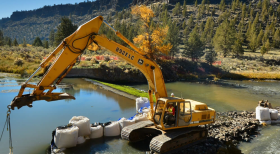
On-the-ground experience from source to sea.
The SWCA team has led or been a key team member of more than 25 dam removals in the Pacific Northwest. Our successful leadership extends across the entire process that includes planning, design, permitting, and overseeing construction of dam removals. Our expertise with these legacy projects is unrivaled due to our on-the-ground experience and involvement with all phases of project execution.
Relevant Services
- Alternatives analysis for dam removal
- Aquatic resources mitigation plans
- Conceptual, preliminary, and final designs
- Concrete dam removal
- Construction administration
- Environmental Impact Statement development
- Geomorphic assessment and habitat analysis
- Hydrology and hydraulic modeling
- Public meetings and outreach
- Reservoir sediment experiments
- Reservoir sediment removal/modeling
- River and reservoir restoration plan
- Site survey, topography, and LiDAR
- Wetland delineation and vegetation mapping
- Work area isolation and fish passage plans
Project Spotlights

Dam Removal
Milltown Dam Removal
From 2003 to 2012, River Design Group, now part of SWCA, played an instrumental role in the planning, design and implementation phases for the multi-year restoration effort of the Clark Fork River following the removal of Milltown Dam. The project included nearly 3 miles of channel restoration and approximately 200 acres of floodplain restoration. Designs addressed channel morphology, floodplain function and aquatic habitat within the context of site constraints. Activation of the new river and floodplain occurred in 2010, with final restoration and project implementation completed in 2012.
*This project was completed by River Design Group, acquired by SWCA in July 2024.

Dam Removal
Gold Ray Dam Removal
Gold Ray Dam was initially built as a log crib structure in 1904 and rebuilt as a concrete dam in 1941 which consisted of a 38-foot-high structure spanning 368 feet across the Rogue River and included a powerhouse with ancillary structures. River Design Group, now part of SWCA, was the engineer of record and technical design leader for the Design-Build team (RDG, HDR, and Slayden Construction Group) that included coordination of public meetings, facilitating permits, development of construction drawings and phasing with the contractor, and quality assurance. Our team members were on-site during all phases of construction to ensure fish passage and salvage actions were undertaken according to approved plans. The entire project was completed within budget and on schedule in a paramount undertaking to open the Rogue River for 157 miles of unhindered fish passage.
*This project was completed by River Design Group, acquired by SWCA in July 2024.
Dam Removal
Rattlesnake Creek Dam Removal & Restoration
Rattlesnake Creek Dam was built in 1901 and served as the primary water source for Missoula until 1983 when Rattlesnake Creek water became contaminated with Giardia. The City of Missoula in partnership with Trout Unlimited and Montana Fish, Wildlife and Parks, is addressing environmental impacts of the dam and associated infrastructure, as well as costs associated with continued management and maintenance of the inactive facility. River Design Group, now part of SWCA, was retained by Trout Unlimited and the City of Missoula to provide planning, design and construction oversight services for the removal of Rattlesnake Creek Dam.
Our team evaluated the current condition of the site and adjacent river corridor, then developed a range of concepts for removing the dam and providing fish passage. Our team also provided technical support to the City for a series of planning meetings and public scoping meetings to evaluate restoration alternatives and redevelopment of the site for recreation.
*This project was completed by River Design Group, acquired by SWCA in July 2024.

Dam Removal
Deschutes Basin Dam Removals
Working with the Crooked River Watershed Council, we removed the Stearns dam on the Crooked River that was a concrete structure originally in the early 1900s and replaced by a concrete structure in 1934. The dam was a low-head irrigation diversion structure (150 feet long by 6 feet high) that was no longer used to divert water and was located on Bureau of Land Management property. River Design Group, now part of SWCA, provided strong leadership to help facilitate stakeholders and regulatory personnel to develop a plan for removal and stabilization of the reservoir sediments to minimize downstream impacts to irrigators. Our staff developed the dam removal plan, hydraulic modeling, engineering design and construction drawings and specifications necessary to remove the dam and reconstruct the channel. Our team also provided project management during project implementation to ensure contractor compliance with the design intent and fish salvage plans. The dam was removed in 2013 and a sediment management plan for over 10,000 cubic yards of stored sediment was developed to ensure long-term stability and fish passage.
*This project was completed by River Design Group, acquired by SWCA in July 2024.

